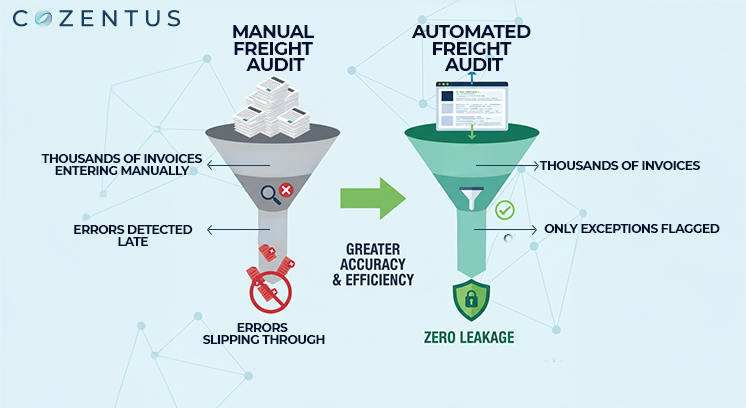The Freight Audit Problem We All Ignore
If you’ve ever watched your finance or logistics team drown in freight invoices, spreadsheets, and endless cross-checks, you know the story all too well.
Freight audits are supposed to be a control mechanism. A way to ensure carriers are billing correctly, rates are honored, and operations stay profitable. But in reality, they’ve quietly become a full-time job.
Each invoice brings its own complexity: mismatched data between TMS and ERP, incorrect surcharges, duplicate charges, or accessorial fees that sneak through. Multiply that by thousands of shipments every month, and suddenly, what should be a routine check turns into a never-ending manual exercise.
It’s slow. It’s repetitive. It’s error-prone. And most importantly, it’s not where your people add the most value.
At Cozentus, we’ve seen global logistics teams spend 30 - 40% of their time just making their invoices accurate. But it doesn’t have to be this way. Let’s discuss more about the problem and the solutions – Automation.

What’s Slowing Down Your Freight Audit Cycle
Traditional freight audit processes are like patching a leaky pipe with tape - it works for a while, until the water starts pouring out somewhere else.
Let’s break it down:
- Manual invoice matching – Teams compare shipment details, rates, and surcharges line by line.
- Data spread across systems – TMS, ERP, carrier portals, and Excel all have different formats and standards.
- Multiple touchpoints – Emails to carriers, calls to confirm disputes, spreadsheets to track everything.
- Late reporting – By the time an audit report is ready, the next billing cycle has already started.
This manual process not only consumes valuable time but also causes human error. Even a 1% inaccuracy rate in freight payments can lead to significant financial leakage across high shipment volumes.
And while businesses aim to reduce logistics costs, many overlook the hidden labor cost of manual audits. This includes hours spent on reconciliation, reviews, and corrections that could have been automated or analyzed in real time.
Why Manual Audits Don’t Scale Anymore
Today’s supply chains move at the speed of automation.
Global enterprises process tens of thousands of shipments daily. That too across multiple carriers, currencies, and geographies. Trying to maintain manual audit checks in this environment isn’t sustainable.
Here’s what we often see in manual setups:
- Audit fatigue: Teams can’t keep up with growing shipment volumes.
- Delayed insights: Finance gets visibility only weeks after the issues.
- Revenue leakage: Errors often go unnoticed until the audit is done.
- Dispute delays: Carriers and finance teams waste a lot of time going back and forth.
Automation eliminates these pain points by helping the team audit in real time, not after weeks. And instead of hiring more analysts, companies can now scale audits intelligently through digital workflows and AI.
Or just partner with Cozentus.
The Best Way to Manage Freight Audits
The smarter approach doesn’t start with more manpower or bigger spreadsheets. It starts with freight audit automation.
At Cozentus, we help logistics and finance teams build intelligent audit systems that handle 80 - 90% of the heavy lifting automatically.
Here’s what that means:
1. Automated Invoice MatchingInvoices are automatically matched against contracts, shipment data, and rate cards using rule-based logic. The system instantly flags discrepancies (such as overcharges, incorrect accessorials, or duplicate invoices), so only the exceptions need human review.
2. Centralized Data IntegrationOur solutions connect seamlessly with existing ERP, TMS, and carrier systems. This ensures that every data point flows into a unified audit layer. No manual imports or reconciliations.
3. Smart Workflows and Exceptions HandlingInstead of manually checking every invoice, your team focuses only on the 5 - 10% that truly need attention. Smart routing ensures issues reach the right stakeholder immediately — whether it’s a carrier, finance approver, or logistics manager.
4. Continuous Learning and AnalyticsWith machine learning and data analytics, your audit system evolves over time. It recognizes common billing errors, identifies risky carriers, and predicts where exceptions are most likely to occur. This helps in turning reactive corrections into proactive cost control.
This is what “smart freight auditing” looks like - faster, more accurate, and infinitely scalable.
How Freight Audit Automation Benefits the Business
Here’s what companies achieve with an automation-first freight audit model powered by Cozentus:
- Up to 95% reduction in manual workload
- 60 -70% faster audit cycles
- 10 - 20% lower logistics cost through error prevention
- Full transparency across carrier payments and exceptions
The result? Finance teams spend less time fixing errors and more time on strategy. Logistics managers get real-time visibility into carrier performance. And leadership gains a data-backed view of where costs are leaking and how to control them.
Automation also ensures compliance, where every audit trail, approval, and dispute is recorded digitally. This minimizes risk during financial reviews or regulatory checks.

A Day with Automation in Freight Audit
Imagine this:
Your team receives thousands of freight invoices daily. Instead of manually verifying them, your system:
- Auto-matches each invoice to shipment data
- Flags only true exceptions for human review
- Generates insights on carrier performance and cost trends
- Syncs approved payments to your ERP automatically
What used to take days now happens in minutes. No manual cross-checking. No late-night Excel sessions.
Just clean, accurate, actionable data - every time.
That’s not a distant vision. It’s the reality Cozentus clients experience today.
You might like this: What Top Freight Operators Are Automating in 2025 (And What They’re Not)
The Next Steps After Automating Freight Audits
Freight audit automation is often the first step toward a fully intelligent logistics network. Once data is digitized and workflows are automated, businesses can layer on other capabilities:
- Real-Time Shipment Visibility: Get unified tracking across all modes and carriers.
- Predictive Analytics: Anticipate delays, cost fluctuations, or route inefficiencies.
- Risk Monitoring: Detect and mitigate disruptions before they affect operations.
- Automated Reporting: Generate insights for finance, operations, and procurement instantly.
At Cozentus, we design connected ecosystems where automation, analytics, and visibility work together, which turns fragmented logistics data into a strategic advantage.
Conclusion: The Best Time to Automate Freight Audit is Yesterday
Manual freight audits made sense when shipment volumes were low and systems weren’t integrated. But today, data moves faster than people can process, and businesses that still rely on manual methods risk falling behind.
The smarter path isn’t replacing people, it’s freeing them from repetitive work so they can focus on decisions, not data cleanup.
Automation brings accuracy. Smart workflows bring speed. Analytics bring insight.
At Cozentus, we bring them all together so that your freight audit process becomes a competitive advantage, not a burden. Because in logistics, time saved is money earned.
Want to save hours daily? Talk to our Expert
Recent Post
Subscribe to our newsletter
Stay updated on latest trends and news in the supply chain and logistics industry








